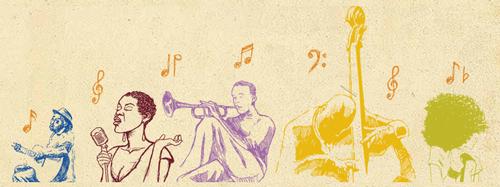African Music: Coming To America
By: Niara Powell
The Role of Music in:
Africa:
In Africa, music was primarily used during important cultural ceremonies. It was seen in weddings, funerals, celebrating child births, religious ceremonies and practices and much more. Music was fully implemented into the way of life for Africans. Whether it was to pass the time while working or using music to tell stories and pass down traditions, music played a big role in both important ceremonies and everyday life in Africa.


African American Community:
Due to the Slave Trade, thousands of Africans were displaced across the seas and with that, so was their music. The role that music played in America was not too far off from how it was used in Africa. During slavery, music was a way for the slaves to get through the treacherous labor and ease the pain of their tribulations. Similarly to that of Africans, African-American music was used to tell stories and speak of messages. Through the genre of Negro Spirituals and later, Gospel, Black Americans were able to use music to connect to their higher selves and provided a means of self expression and release.
The Performance:
The performance of music in both the African community and African American community facilitated a very similar experience. In both videos you can see that the performances of music are community based and focused on being a collective. On the right is a traditional African performance and you can see that it heavily involves movement to go along with the music. While there are people playing on drums and animal skins in the back, there are also people (usually women) performing dances in front to go along with what is being portrayed and to add on to the self expression factor. In the video on the left, you can see African Americans performing spirituals, also as a collective. Although it is not clearly shown in this video, the sense of movement was also passed down from Africans to African Americans and the way of stomping, clapping, swaying, or snapping is also an important part of African American spiritual performance. One thing that did change was that African Americans tended to put more of an emphasis on the usage of voice and words to spread a message and express themselves rather than focusing specifically just on the beats and dancing.
Timbre:
Timbre is the tone quality of music that allows listeners the ability to distinguish between instruments and vocal notes that are used within a song even when the same note is being either played or sung at the same time. African and African American music utilizes timbre while Europeans do not as much. In African and African American music, timbre can include an array of instruments, shouts, screams, stomps, claps, and or snaps. European music does not include as much of this and this is why it does not have the unique sound or character of that of Black music.

Musical Structures:
As stated before, a common parallel between African and African American music is the communal experience. Due to this, two of the most common musical structures that are found in these two cultures of music are Call and response and Polyrhythm. Starting with Call and Response, it is a technique that engages interaction from the crowd. The artist may say one line and then prompt the crowd to respond to that. The next structure is a polyrhythmic structure that involves taking contrasting rhythms from different instruments entering at different times and layering them in a unique way. This contributes to the experience of community because through this musicians can can add their own sounds into a song. Also, this technique allows for songs to be easier to memorize and better to create dances to due to the depth of the sound.
More Works By Author
Story of Jazz Notes (Pt. 1)
The Story of Jazz Notes (Pt.1) /*! elementor – v3.4.4 – 13-09-2021 */ .elementor-widget-image{text-align:center}.elementor-widget-image a{display:inline-block}.elementor-widget-image a img[src$=”.svg”]{width:48px}.elementor-widget-image img{vertical-align:middle;display:inline-block} Jazz used to be considered “sin music”
Commodification of AA Music
/*! elementor – v3.4.8 – 16-11-2021 */ .elementor-heading-title{padding:0;margin:0;line-height:1}.elementor-widget-heading .elementor-heading-title[class*=elementor-size-]>a{color:inherit;font-size:inherit;line-height:inherit}.elementor-widget-heading .elementor-heading-title.elementor-size-small{font-size:15px}.elementor-widget-heading .elementor-heading-title.elementor-size-medium{font-size:19px}.elementor-widget-heading .elementor-heading-title.elementor-size-large{font-size:29px}.elementor-widget-heading .elementor-heading-title.elementor-size-xl{font-size:39px}.elementor-widget-heading .elementor-heading-title.elementor-size-xxl{font-size:59px} Black Music For Sale! By: Niara Powell What is commodification? Commodification
1930’s and 40’s Jazz
/*! elementor – v3.4.8 – 16-11-2021 */ .elementor-heading-title{padding:0;margin:0;line-height:1}.elementor-widget-heading .elementor-heading-title[class*=elementor-size-]>a{color:inherit;font-size:inherit;line-height:inherit}.elementor-widget-heading .elementor-heading-title.elementor-size-small{font-size:15px}.elementor-widget-heading .elementor-heading-title.elementor-size-medium{font-size:19px}.elementor-widget-heading .elementor-heading-title.elementor-size-large{font-size:29px}.elementor-widget-heading .elementor-heading-title.elementor-size-xl{font-size:39px}.elementor-widget-heading .elementor-heading-title.elementor-size-xxl{font-size:59px} 1930’s and 40’s: Jazzin’ Up an Era By: Niara Powell Background
Record Row, Where Did It Go?
/*! elementor – v3.4.7 – 31-10-2021 */ .elementor-heading-title{padding:0;margin:0;line-height:1}.elementor-widget-heading .elementor-heading-title[class*=elementor-size-]>a{color:inherit;font-size:inherit;line-height:inherit}.elementor-widget-heading .elementor-heading-title.elementor-size-small{font-size:15px}.elementor-widget-heading .elementor-heading-title.elementor-size-medium{font-size:19px}.elementor-widget-heading .elementor-heading-title.elementor-size-large{font-size:29px}.elementor-widget-heading .elementor-heading-title.elementor-size-xl{font-size:39px}.elementor-widget-heading .elementor-heading-title.elementor-size-xxl{font-size:59px} Record Row What Where Why Independent Record Companies Had an emphasis

The Sizzling Summer of Soul
/*! elementor – v3.4.7 – 31-10-2021 */ .elementor-heading-title{padding:0;margin:0;line-height:1}.elementor-widget-heading .elementor-heading-title[class*=elementor-size-]>a{color:inherit;font-size:inherit;line-height:inherit}.elementor-widget-heading .elementor-heading-title.elementor-size-small{font-size:15px}.elementor-widget-heading .elementor-heading-title.elementor-size-medium{font-size:19px}.elementor-widget-heading .elementor-heading-title.elementor-size-large{font-size:29px}.elementor-widget-heading .elementor-heading-title.elementor-size-xl{font-size:39px}.elementor-widget-heading .elementor-heading-title.elementor-size-xxl{font-size:59px} The Sizzling Summer Of Soul What is the Summer of Soul

Music From Africa to America
/*! elementor – v3.4.8 – 16-11-2021 */ .elementor-heading-title{padding:0;margin:0;line-height:1}.elementor-widget-heading .elementor-heading-title[class*=elementor-size-]>a{color:inherit;font-size:inherit;line-height:inherit}.elementor-widget-heading .elementor-heading-title.elementor-size-small{font-size:15px}.elementor-widget-heading .elementor-heading-title.elementor-size-medium{font-size:19px}.elementor-widget-heading .elementor-heading-title.elementor-size-large{font-size:29px}.elementor-widget-heading .elementor-heading-title.elementor-size-xl{font-size:39px}.elementor-widget-heading .elementor-heading-title.elementor-size-xxl{font-size:59px} African Music: Coming To America By: Niara Powell The Role of


